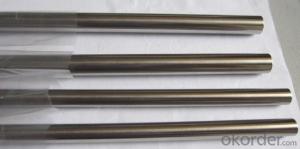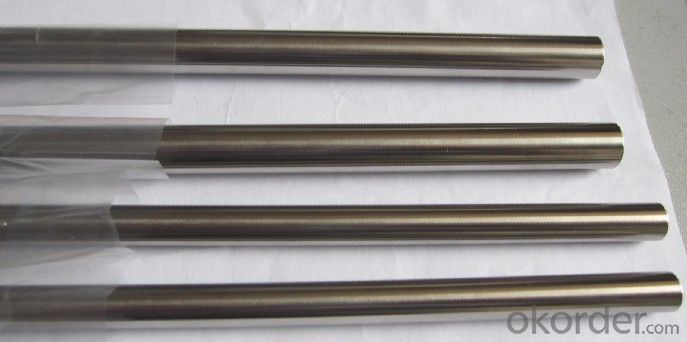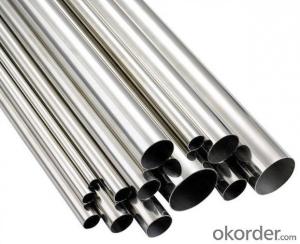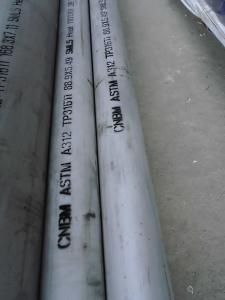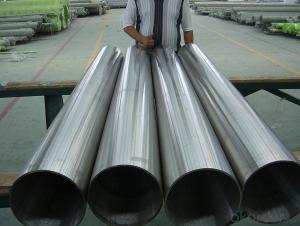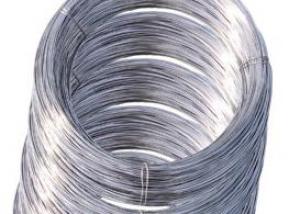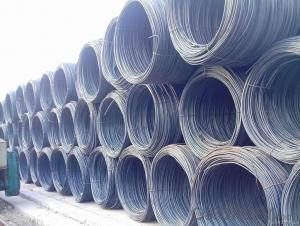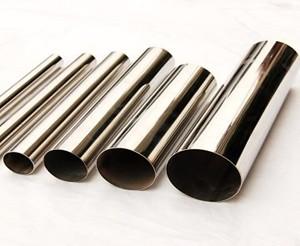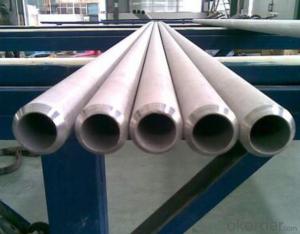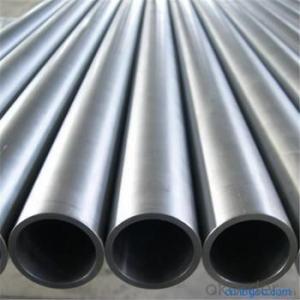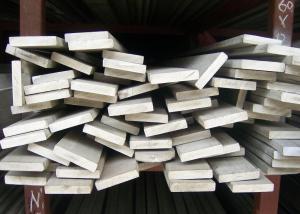stainless steel free cutting 303 stainless steel rods
- Loading Port:
- Shanghai
- Payment Terms:
- TT OR LC
- Min Order Qty:
- 1000 kg
- Supply Capability:
- 10000 kg/month
OKorder Service Pledge
OKorder Financial Service
You Might Also Like
Packaging Detail: | Bundle or Container or as per customers requirement. |
Delivery Detail: | within 25 days after we receive an irrevocable L/Cor 30% deposit |
ASTM A335 Seamless Alloy-Steel Pipe
Standard: BS 1139, BS 3059-2, JIS G3454-2007
Grade: 10#-45#, 15NiCuMoNb5, 10Cr9Mo1VNb
Detailed introduction to ASTM A335 seamless alloy steel pipe:
ASTM A335 seamless alloy steel pipe
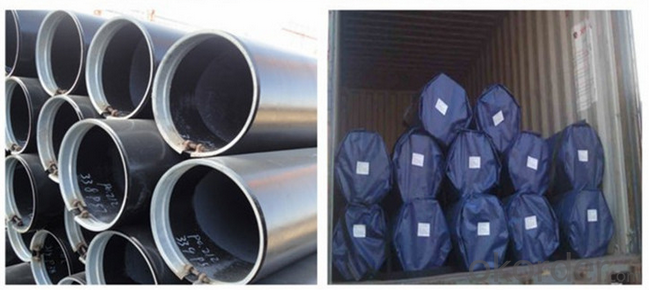
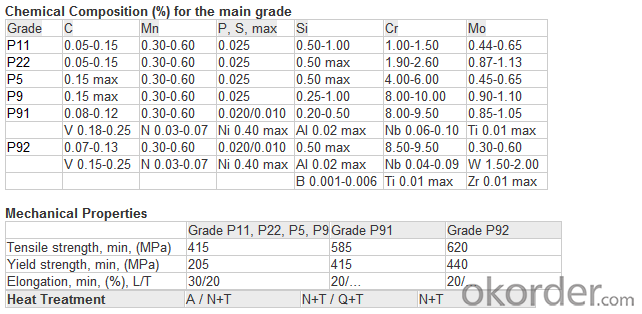
FAQ:
1) why you chose us ?
Professional Manufacturer and supplier of Steel pipe
More than 14 years’ professional producing experience
We can get the lowest ex-factory prices. The price are quite reasonable and it is lower than our commercial peers. also, we can guarantee the qualities of our products.
BV, ISO certificates and SGS test can be provided to assure the quality of our products.
2) Our minimum order quantity:
10 Metric Tons or one 20ft or 40ft Container.
3) How about the Delivery Time?
The steel pipe will be produced since we getting your deposit by T/T or Your original L/C. For normal size, some stocks in our factory now, we can supply once you need.
4)What kind of payment does your company support?
T/T, 100% L/C at sight, Cash, Western Union are all accepted.
5) Do you charge for the samples?
According to our company principle, we just charge for samples, you pay for the freight /courier charge.
6) Main market:
Mid East, South America, Africa, Southeast Asia, India etc
- Q: Classification, advantages and disadvantages of stainless steel welding
- Metal gas shielded arc welding.It belongs to the gas protection welding, also is a kind of arc welding, that is, in the protection of gas, welding rod arc melting. Metal gas welding can be used in steel, non alloy steel, low-alloy steel and high alloy, etc. these materials are widely used. But one thing, its protective gas must be an active gas, such as carbon dioxide or a mixture of gases. The only drawback is that if the outdoor welding, then the workpiece can not be damp, otherwise it will affect the protection of gas protection effect.
- Q: Can stainless steel pipes be insulated with cork?
- Yes, stainless steel pipes can be insulated with cork. Cork is a versatile material that is commonly used for insulation purposes. It has excellent insulating properties, including thermal insulation, noise reduction, and fire resistance. Cork insulation is suitable for various applications, including pipes, as it can effectively reduce heat transfer and prevent condensation. Additionally, cork is a sustainable and eco-friendly material, making it a popular choice for insulation. Therefore, using cork to insulate stainless steel pipes is a viable option.
- Q: Can stainless steel pipes be used for wastewater treatment ponds?
- Yes, stainless steel pipes can be used for wastewater treatment ponds. Stainless steel is highly resistant to corrosion and can withstand the harsh conditions and chemicals typically found in wastewater treatment facilities. It is a durable and long-lasting material that can effectively transport wastewater and withstand the demands of the treatment process.
- Q: What is the difference between 304J2 and 316J2 stainless steel pipes?
- 304J2 and 316J2 stainless steel pipes differ primarily in their chemical composition and the presence of specific elements. 304J2 stainless steel is a variation of the popular 304 grade. It possesses approximately 18-20% chromium and 8-10.5% nickel, resulting in commendable corrosion resistance, particularly in mildly corrosive surroundings. Nevertheless, its molybdenum content is lower compared to 316J2. In contrast, 316J2 stainless steel is a variant of the 316 grade. It contains roughly 16-18% chromium, 10-14% nickel, and 2-3% molybdenum. The augmented molybdenum content heightens its resistance to corrosion, making it suitable for more aggressive settings like marine or chemical applications. Regarding mechanical properties, both grades exhibit similar tensile and yield strength. However, due to the elevated levels of nickel and molybdenum, 316J2 stainless steel pipes generally display superior resistance to pitting and crevice corrosion. Ultimately, the selection between 304J2 and 316J2 stainless steel pipes relies on the specific application and the extent of corrosion resistance desired. While 304J2 suffices for general use in mildly corrosive environments, 316J2 is preferable when exposure to more aggressive conditions is anticipated.
- Q: How do you clean and maintain stainless steel pipes?
- To clean and maintain stainless steel pipes, start by wiping them down with a mild detergent or soap and warm water using a soft cloth or sponge. Rinse thoroughly and dry with a clean cloth to prevent water spots. Avoid using abrasive cleaners or scrub brushes that can scratch the surface. Regularly inspect the pipes for any signs of corrosion, staining, or damage, and promptly address any issues to prevent further deterioration. Additionally, applying a stainless steel cleaner or polish can help remove stubborn stains and restore the shine of the pipes.
- Q: How do stainless steel pipes compare to carbon fiber pipes?
- Stainless steel pipes and carbon fiber pipes have their own unique characteristics and are used in different applications. Stainless steel pipes are known for their durability and strength. They are highly resistant to corrosion and can withstand high temperatures and pressures. This makes them suitable for various industries such as oil and gas, chemical, and construction. Stainless steel pipes have a longer lifespan and can handle heavy loads, making them a reliable choice for many applications. However, stainless steel pipes are relatively heavy and may require additional support structures. On the other hand, carbon fiber pipes are lightweight and have a high strength-to-weight ratio. They are made from carbon fibers embedded in a resin matrix, resulting in a strong and rigid material. Carbon fiber pipes are commonly used in industries such as aerospace, automotive, and sports equipment. The lightweight nature of carbon fiber pipes allows for increased fuel efficiency in vehicles and improved performance in sports equipment. However, carbon fiber pipes are more expensive than stainless steel pipes and may not be as resistant to extreme temperatures or corrosive environments. In summary, stainless steel pipes are known for their durability and resistance to corrosion, making them suitable for heavy-duty applications. Carbon fiber pipes, on the other hand, are lightweight and offer high strength-to-weight ratio, making them ideal for applications where weight reduction is critical. The choice between stainless steel and carbon fiber pipes ultimately depends on the specific requirements of the application and the trade-offs between cost, weight, and performance.
- Q: What are the common applications for stainless steel pipes?
- Stainless steel pipes have a wide range of applications due to their unique properties and versatility. Some of the common applications for stainless steel pipes include: 1. Plumbing and water supply systems: Stainless steel pipes are commonly used in plumbing and water supply systems due to their corrosion resistance and ability to withstand high pressure. They provide a reliable and long-lasting solution for transporting water and other fluids. 2. Oil and gas industry: Stainless steel pipes are extensively used in the oil and gas industry for transporting oil, gas, and other hydrocarbons. They can withstand high temperatures and pressures, making them suitable for exploration, production, and transportation of these resources. 3. Food and beverage industry: Stainless steel pipes are widely used in the food and beverage industry due to their hygienic properties and resistance to corrosion. They are commonly used for transporting liquids, such as milk, juices, and processed foods, ensuring the safety and quality of the products. 4. Chemical and pharmaceutical industry: Stainless steel pipes are highly resistant to corrosion, making them ideal for the chemical and pharmaceutical industry. They are used for transporting various chemicals, acids, and solvents, ensuring the integrity of the substances being transported. 5. Construction and architecture: Stainless steel pipes are used in construction and architectural applications due to their aesthetic appeal and structural strength. They are often used for handrails, balustrades, structural columns, and decorative applications, adding a modern and sleek look to buildings. 6. Automotive industry: Stainless steel pipes are utilized in the automotive industry for exhaust systems due to their heat resistance and durability. They can withstand high temperatures and corrosive gases, ensuring the efficient operation of the exhaust system. 7. Power generation: Stainless steel pipes are used in power plants for transporting steam, water, and other fluids. They are resistant to high temperatures and pressures, making them suitable for power generation applications. 8. Aerospace industry: Stainless steel pipes are utilized in the aerospace industry for various applications, including aircraft exhaust systems, hydraulic systems, and fuel lines. They offer high strength-to-weight ratio, corrosion resistance, and reliability, meeting the stringent requirements of the aerospace industry. In summary, stainless steel pipes find applications in various industries due to their corrosion resistance, durability, and versatility. They are used in plumbing, oil and gas, food and beverage, chemical and pharmaceutical, construction, automotive, power generation, and aerospace industries, among others.
- Q: Can stainless steel pipes be used for oil pipelines?
- Indeed, oil pipelines can utilize stainless steel pipes. Renowned for its exceptional resistance to corrosion, stainless steel is an ideal material for the transfer of diverse fluids, such as oil. Moreover, its durability and ability to withstand high pressure and temperature circumstances further enhance its suitability for oil pipelines. Additionally, the smooth inner surface of stainless steel pipes aids in diminishing friction and enhancing the oil's flow. Nevertheless, it is vital to carefully contemplate the selection of stainless steel grade and appropriate coating to guarantee compatibility with the specific type of oil and the prevailing environmental conditions in which they will be employed.
- Q: What is the difference between 304 and 304H stainless steel pipes?
- The main difference between 304 and 304H stainless steel pipes lies in their carbon content. While both materials are made up of the same elements, including iron, chromium, and nickel, 304H stainless steel contains a higher carbon content compared to 304 stainless steel. The increased carbon content in 304H provides improved high-temperature strength and creep resistance, making it more suitable for applications that involve elevated temperatures. Because of its higher carbon content, 304H stainless steel pipes have better resistance to sensitization during welding, which is the formation of chromium carbides at the grain boundaries. This can lead to intergranular corrosion and reduced mechanical properties. By incorporating a higher carbon content, 304H stainless steel pipes can resist this sensitization phenomenon and maintain their structural integrity even at high temperatures. In terms of other properties, both 304 and 304H stainless steel pipes offer excellent corrosion resistance, good weldability, and high strength. They are widely used in various industries such as oil and gas, chemical, food processing, and pharmaceuticals. However, it is important to note that 304H stainless steel pipes are typically recommended for applications requiring high-temperature strength, while 304 stainless steel pipes are more commonly used for general-purpose applications. In summary, the difference between 304 and 304H stainless steel pipes lies in their carbon content. 304H stainless steel pipes have a higher carbon content, providing improved high-temperature strength and resistance to sensitization during welding. It is important to consider these differences when selecting the appropriate stainless steel pipe for a specific application.
- Q: Can stainless steel pipes be insulated with polyurethane?
- Certainly! Polyurethane insulation is frequently utilized in multiple industries, such as plumbing and HVAC systems, for both thermal and acoustic insulation. Its outstanding thermal conductivity properties and minimal moisture absorption make it an excellent option for insulating stainless steel pipes. There are two methods to apply polyurethane insulation: as a foam or in pre-insulated pipe sections. By minimizing heat loss or gain, avoiding condensation, and enhancing energy efficiency, it effectively insulates the pipes. Moreover, polyurethane insulation is long-lasting, lightweight, and corrosion-resistant, making it a suitable choice for insulating stainless steel pipes in diverse applications.
Send your message to us
stainless steel free cutting 303 stainless steel rods
- Loading Port:
- Shanghai
- Payment Terms:
- TT OR LC
- Min Order Qty:
- 1000 kg
- Supply Capability:
- 10000 kg/month
OKorder Service Pledge
OKorder Financial Service
Similar products
Hot products
Hot Searches
Related keywords
